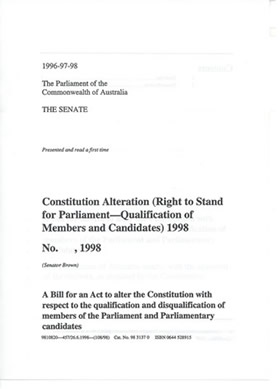135 Bills amending the Constitution
If the third reading of a bill proposing an alteration of the Constitution is not carried by an absolute majority of the Senate the bill shall be forthwith laid aside without any question being put, and shall not be revived during the same session.
Amendment history
Adopted: 19 August 1903 as SO 234 but renumbered as SO 233 for the first printed edition
1989 revision: Old SO 242 renumbered as SO 135; part of original content moved to SO 110 (Roll call for Constitution alteration bills); expression streamlined
Commentary

This bill to alter the Constitution was agreed by a majority of senators but failed to secure the absolute majority required by the Constitution
This standing order, along with old chapter XXI (Call of the Senate) had been proposed for deletion in the 1989 revision but was restored at the request of senators.[1] These procedures had only ever been used for Constitution alteration bills and were often suspended in any case.
The standing order does not require bills to alter the Constitution to be agreed to by an absolute majority of the Senate. This requirement is set out in s.128 of the Constitution. The purpose of the standing order is to provide for the fate of bills which fail to meet this requirement. See Odgers’ Australian Senate Practice, 12th edition, Chapter 12, under “Bills to alter the Constitution”.
In 2003, a bill introduced by a private senator to alter the Constitution was passed by a majority – but not an absolute majority – of the Senate. When a division on the third reading revealed this shortfall in votes, the bill was ordered to be laid aside pursuant to SO 135.[2]